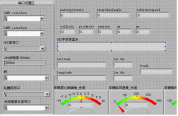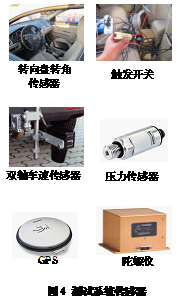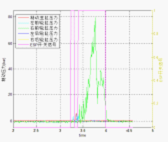Application areas:
Signal acquisition / product testing
challenge:
The electronic stabilization system (Electroni-c Stability Program, ESP for short) is not only very demanding on the site, but also dangerous in the course of the experiment, and requires many signals to be measured. The experimental data collection system must not only be able to collect various signals, but also be able to work stably and reliably in harsh test environments (such as shock, vibration, high temperature, high humidity, etc.).
application solution:
Faced with the harsh test environment of ESP system testing and numerous test signals, based on the NI PXI and LabVIEW test platform, we quickly integrated a variety of signal acquisition and processing such as analog signals, digital signals, CAN, serial ports, etc. in a short time . The NI data acquisition system successfully completed the data acquisition of the ESP test process at the Hainan Proving Ground, ensuring the smooth progress of the test.
Products used:
LabVIEW 2009 software development platform
PXI-1042Q 8-slot PXI chassis
PXI-8106 embedded real-time controller
PXI-6251 M series data acquisition card
PXI-6259 M series data acquisition card
PXI-8430 serial port card
PXI-6608 digital IO module
PXI-8512 CAN card
Overview
The automotive electronic stability control system can assist the driver to control the dynamic characteristics of the vehicle, control the yaw rate of the vehicle by controlling the braking force of the wheels and the output torque of the engine, and limit the slip angle to a certain range to assist driving The crew maintains the stability of the car under extreme conditions to prevent the vehicle from becoming unstable.
In recent years, with the increase in people's active safety requirements for vehicles and the promotion of corresponding safety regulations in various countries, the standard assembly rate of ESP systems on automobiles has rapidly increased. Bosch, mainland and other foreign automotive electronic product suppliers have equipped ESP systems with The mass supply capacity has occupied a major market share.
The domestic ESP system research started late, mostly staying in the theoretical control research and hardware-in-the-loop simulation stage. Most domestic vehicle and component manufacturers directly use ESP systems such as Bosch, Continental and TRW to match the self-developed vehicles.
Compared with the domestic ESP system strategy research, the research on ESP system performance test evaluation methods is basically blank. Most verification experiments refer to the test methods of foreign parts suppliers or corresponding institutions or directly entrust the test to the supplier for implementation. At present, the domestic automotive industry has not yet formed a unified ESP test standard, which makes it difficult for domestic vehicle manufacturers to systematically evaluate ESP control performance, and it is impossible to propose a complete product design to automotive electronics suppliers at the product design stage based on the test results. The technical requirements have greatly increased the matching design cycle and R & D costs of the chassis control system of vehicle manufacturers and automotive electronics suppliers.
In view of the above circumstances, the research team combined with the current research foundation, put forward a set of automotive chassis electronic control system performance evaluation and experimental test process specifications and built a measurement and control system platform for ESP system test and test.
ESP system test platform
The ESP system test platform built by the research team mainly includes three parts: 1. ESP test test procedure specification; 2. Test data collection system; 3. Test evaluation standard.

Figure 1 ESP system test platform architecture
The test and test procedure specification specifies the test items, test objectives, test variables and instruments, test conditions, test methods, and test data processing methods required for ESP testing.
The test evaluation standard serves as a guide for the evaluation of the performance of the electronic control system and the vehicle. Based on the relevant basic theories of the vehicle, the method and corresponding principle of performance evaluation are specified.
The test data acquisition system includes sensors, data acquisition cards and related software that measure the required variables (vehicle parameters and motion status) during the test. The performance of the test data collection system determines to a certain extent whether the entire test system can accurately evaluate the performance of the entire vehicle and the advantages and disadvantages of the ESP system.
ESP is the latest generation of automotive active safety system. ESP is a system that improves vehicle stability by applying accurate control to the critical instability of the vehicle based on vehicle dynamics. Therefore, in order to verify the performance of the ESP system, a large number of actual vehicle tests are required. Completing the test data collection will face two major difficulties: First, there are many test equipment (GPS, gyroscope, non-contact photoelectric speedometer, wheel speed sensor, pressure sensor, trigger, etc.), second, the test environment is harsh (impact, shock, Vibration, high temperature, high humidity, etc.). Through research, we chose NI PXI and LabVIEW test platform.

Figure 2 ESP data acquisition system interface

Figure 3 PXI chassis of ESP data acquisition system


Figure 5 ESP single-track test vehicle trajectory

Figure 6 Brake pressure of ESP single transfer line test wheel cylinder
in conclusion
ESP is a major direction for the development of future automotive active safety systems. ESP real vehicle road test is not only the final evaluation method of ESP control system. ESP real vehicle road test also has certain guiding significance in the development stage of ESP control algorithm.
Based on the good scalability of the PXI system, we quickly built a test platform for the ESP system performance test. In an extremely harsh test environment, the test system accurately and effectively collected the test signal of the ESP system test, which greatly promoted the 863 plan chassis control The systematic research provides a powerful support for the further improvement of our autonomous chassis electronic control system.
Author: High Zhenhai Wang Jun Cui Xin Guo Jian love
State Key Laboratory of Automotive Dynamic Simulation, Jilin University
LED Linear Light is a kind of high-end flexible decorative lamp, advantages with low power consumption, long life, high brightness, easy to bend, maintenance free and so on.
It is especially suitable for indoor and outdoor entertainment places, building outline and billboard making.
According to different requirements, the product has 12V, 24V, 30CM,60CM, 90CM, 120CM and so on.Line lamps of different specifications can also be customized according to customer requirements.LED Linear Light
Linear Light,Linear Lamp,Led Linear Lighting,Linear Ceiling Light
Jilin Province Wanhe light Co.,Ltd , https://www.wanhelight.com
